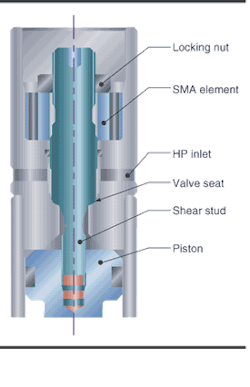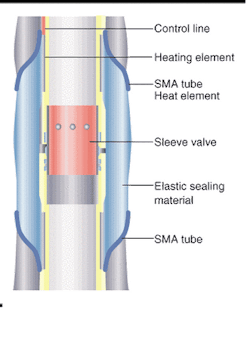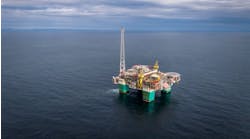Part II: "Smart metals' providing actuation, sealing, and connection functions downhole
Leonard Le Blanc
Editor-in-Chief
PART II: This is the second of a two-part series. Part I focused on the theory behind shape metal alloys. Part II features downhole well applications now being made using 'smart metals' technology.
Petroleum industry manufacturers and service companies are utilizing shape metal alloys, also known as 'smart metals,' in products for oil and gas drilling, completion, and production functions, at the wellhead and downhole. A large number of US and European patents have been granted to protect applications for shape metal alloys (SMA), although the technology has been around for decades.
Primary users of SMA technology have been the aerospace and medical communities, the former because of the precision and reliability of SMA (for example, creating huge antenna arrays from compressed packages), and the latter because the pre-expansion SMA device can be engineered to fit in very tiny packages (for example, routed through small blood vessels).
The useful characteristic of shape metal alloys (SMA) is the alteration of the material's mechanical properties by changes in temperature. Heat is applied to the alloy, usually by circulating a hot fluid, applying electrical resistance heating, or by mixing chemicals downhole to create an exothermic reaction. The heat induces a strong physical or dimensional change, which makes SMA materials excellent candidates for actuation and release.
Besides actuation, there are two other broad areas of application for SMA materials - sealing and connection. A review of some of the patents applied for and granted, and the studies of a Norwegian research group, Sintef, show how applications in the three broad areas make use of 'smart metal' technology. Many of the SMA patent applications are in areas cited by Sintef as critical in providing new functions or replacing conventional processes. They include:
- Release system for setting downhole tools
- Downhole linear activation mechanism with a long stroke
- Sliding sleeve valve (side door valve) to open communication between tubing and casing annulus
- Formation tester for opening and closing a ball valve to admit and close off flow into a chamber for testing
- High expansion casing patch for damaged or leaking casing
- External casing sealing method that activates cup-shaped supports against the formation above and below the area to be sealed, and into which sealing material is injected
- Split rings that seal the bore during latching functions
- Pre-perforated casing that opens communication with the formation, a process that eliminates perforating guns in zones with good natural drive
- Bolt tensioning washers used for pre-loading bolts in flange connections to obtain the correct tension in bolts without generating shear stress
- Self tensioning bolts for flange connections, that also obtain the correct tension in bolts without generating shear stress
- Composite riser coupling with profiles (outer, inner, or both) that grip and seal
- Large pipe coupling that keep an outer metal ring in position and press sharp edges of the internal diameter ring into the pipe for gripping and sealing
- Multi-lateral connections that anchor the lateral tubes into position for drilling and sealing the casing junction.
Many of the patents applied for recently include devices for meeting these technical goals, although the patent details are not yet clear, nor have the patenting companies announced work until the patent is granted. Details are available for patents granted, and it is clear that the use of SMA in aerospace and medicine has made it difficult to patent outside of very specific SMA applications, which will be cited in this paper.
Actuation function
The greatest area of interest for SMA researchers is actuation. The shortcomings of current actuation technology are a limited length of the actuation stroke, often unsuitable force/ stroke ratios, problems in sealing at the actuation site, and premature setting. Some conventional types of actuation require the use of explosives, or operation in an environment clear of electro-magnetic frequencies at the surface and downhole. Neither condition is ideal for drilling and completion teams.
SMA actuation can solve some of these problems, especially where a long or unlimited stroke is required, where explosives could go off prematurely, creating costly damage downhole, and where hydraulic pressure is not convenient to apply to a downhole device.
An SMA compression element can be used as a trigger downhole for a power spring package, either as a main tool or as a backup to conventional devices. As shear pins are cut, series-connected springs provide axial motion to set casing patches, straddle packers, plugs, hangers, and actuate a number of other functions downhole. Alternatively, an SMA compression element can be used to shear off a shear-ring at a calibrated weak point. The SMA element function is triggered by electricity.
For axial actuation, Sintef suggested two of the best SMA alloy combinations to use are Cu-Al-Ni (copper/aluminum/nickel) and Ni-Ti-Hf (nickel/ titanium/hafnium). Heat input for the two alloys are about 3kW, which can be provided downhole on a 4,000-meter-long, 3/32-in. monocable.
Several patents issued in recent years demonstrate the variety of acutation uses considered. Two patents were issued to Memory Metal Inc., one of which focuses on sealing a well blowout, and the other for closing and opening a subsurface well safety valve and control system.
The well blowout device seals the well with dual SMA helical coil springs, one for closing the borehole valve, and the other for opening it. The spring slides over ratchet teeth, which lock the valve in position.
The subsurface valve uses SMA helical coiled springs, which normally remain open when heated by electrical current. When the current is switched off, the spring closes the valve. Memory Metal received two other patents, both for setting packers in wellbores with SMA-actuated devices.
Dril-Quip, Inc. and Camco, Inc. separately hold patents for sealing the annular space outside a casing string with an SMA-set device. The Dril-Quip version seals with an SMA ring that, once energized, seals the space. The Camco version uses a series of V-shaped sealing elements that expand, sealing in a radial direction, and once transformed to the austenite state, hold their position in the wellbore.
There are other patent holders for SMA-set actuation devices:
- Shell holds a patent for a wellbore, casing, or tubing sealing and isolation system that uses SMA cylinders lowered into the wellbore, which can be heated and expanded against the inside of the tube to be sealed or isolated.
- Dresser (Halliburton) holds a patent for a downhole perforation gun system triggered by an SMA device. The system eliminates barrel expansion, which in turn extends the life of the gun transport system.
- Smith International has a patent for a dual-squeeze seal gland in drill bit bearings. The force on the O-ring, which keeps drill fluid out of the bearing area, must increase over the life of the bit as the bearing wears and eccentricity sets it. A ring made of SMA material changes shape as friction heats up the material during incremental wear, thereby increasing the force on the O-ring, and extending the life of the bearings.
Connection function
The study conducted by Sintef outlined a second function - connections - in which SMA technology could be applied. There were three major types of functions:
- Pipe connections can be made without rotating the two joints, by encircling them with SMA (nickel-titanium-niobium alloy appears to be the alloy of choice here) rings with sinus shaped grooves for gripping. The diameter of the ring is then reduced with heat. To reverse the process, the ring can be expanding by applying liquid nitrogen, which expands it by converting it back to the original pre-set martensitic alloy form, from the autensitic set form.
- Coiled tubing and composite tubing sections can be connected by using an SMA element. The diameter of the internal element is increased by heating it, allowing the outside surface to contact the pipe sections. Friction elements hold the joined sections tightly. All welding and hot work are eliminated. The SMA-set process has two negatives: the internal sleeves do reduce the internal diameter somewhat, and in the case of coiled tubing, the existance of the sleeve can be a problem for spooling.
- SMA bolted connections can be used to connect flanges. The bolt is pre-tensioned by heating an expanded SMA collar, thereby eliminating the use of a torque wrench. No shear stresses are applied during the pretensioning process. The connection strength is decided by the engineer, not the user, and a paint indicator on the SMA collar indicates when the heating function is complete.
Sealing function
In addition to opening up sliding sleeves, tubing, and activating other functions downhole, SMA-set materials can be used in sealing pipe and tubing downhole, and in closing off zones.
For example, a slotted liner made up of SMA materials can be inserted through a narrow borehole diameter and expanded with a downhole heat source to support any number of sealing functions. There were four apparent advantages in the use of SMA materials for sealing, according to the Sintef study:
- The SMA process eliminates the use of an expansion mandrel, which is sometimes difficult to insert and activate in small borehole or casing diameters.
- An SMA liner can fill irregular cross-sections in zones or even damaged casing, something that expansion mandrels are not effective in doing.
- SMA materials provide a high expansion radius (pre-set to set that can be as high as 600%), an important factor when the insertion diameter is small and the zone is washed out or collapsed.
- SMA materials normally remain at the maximum-set diameter and do not reduce, a process that sometimes takes place in the use of conventional materials.
In the sealing process, the Sintef study cited the use of SMA rings in production packers and liner hanger seals. The SMA ring combines sealing and anchoring and will not set until heat is applied by wireline tools, eliminating the risk of premature setting. The SMA ring can replace the conventional elastomer sealing and slips process used in production packers. Other uses of SMA sealing applications include the following:
- Trouble zones: Heat-expanded slotted casing, combined with a fibrous cement, can be used to close off trouble zones downhole. The advantages in using an SMA framework to set the slotted casing is that no internal diameter is lost, and the slotted casing fills irregular cross sections. During the drilling phase, the SMA process can eliminate the use of intermediate casing - an important consideration.
- Liner repairs: When casing or tubing sections are corroded or leaking, SMA-set 'scab liners' can be lowered into position to anchor to the good sections and seal off weaker sections. The benefits are the liner's low cost and the use of metal-to-metal contacts, which eliminates elastomers. The latter is important in wells where the elastomer reacts chemically to production or injection components.
- Close circulation ports: Circulation ports in production tubing sections made of SMA materials can be closed off by simply applying heat. The design is relatively simple, and the metal-to-metal closing process eliminates elastomers.
Patents for various sealing functions utilizing SMA materials have been filed by companies such as Camco, Baker Hughes, Memory Metal, Dril-Quip, Shell Oil, Dresser Industries (Halliburton), Sperry Corporation, and Smith International.
According to a patent granted to Baker Hughes, the firm developed a device for sealing the junction between a vertical well and one or more horizontal wells using a deformable mechanism. The assembly is passed through the existing casing and positioned within a lateral window. Heat is applied and the assembly regains its original shape, setting up the laterals.
In a second patent application, Baker Hughes developed a sealing flap used to grip and seal a liner to the casing. The flap is radially expanded by a wedge, which is moved axially by an SMA actuator.
Other applications
There are other applications areas cited by the Sintef study that expand the use of SMA materials or setting technology into functions other than actuation, sealing, or connections. They include such examples as:
- Fishing tools: A wireline or coiled tubing fishing tool uses the basket concept to surround, close firmly around an object in the borehole, and then lift it to the surface. The basket, made up of SMA elements, expands and contracts, according to the heat applied to it.
- Centralization: A casing centralizer can use SMA elements to centralize tubing or casing as needed. Heat is applied to either activate SMA centralizer vanes or an SMA spring that sets standard centralizers. The process can be reversed when the tubing or casing has to be withdrawn or allowed to drift when other strings are lowered into the well or casing section.
Two other examples include acoustic dampening downhole, where certain temperatures on SMA materials serve to significantly dampen sound on strings in the borehole, and cable covers, where downhole electrical cables are shielded by super-elastic SMA material, which makes it highly torquable and easy to thread through tortuous sections.
With so many downhole needs and the developing utility of SMA materials, chances are good that the petroleum industry will make as good a use of them as the aerospace and medical industries. Many of the SMA applications are still in trial, and don't have the years of function and reliability experience that operators would like to see. But this may change shortly.
Acknowledgement
Contributing to this paper are Allen Gault, Senior Staff Engineer with Conoco ([email protected]); Dr. Richard Haut, Integrated Technologies Manager for Halliburton Deepwater ([email protected]); Dr. Hans Juvkam-Wold, Holt Chair Professor in the Department of Petroleum Engineering at Texas A&M University ([email protected]); Dr. Dimitris C. Lagoudas, Ford Professor of Aerospace Engineering with Texas A&M University ([email protected]): Dr. Dave Zimmerman, Professor of Engineering in the Mechanical Engineering Department at the University of Houston ([email protected]).
Reference
Lagoudas, D., (Untitled), not published.
SINTEF Petroleum Research; "Detailed study of shape memory alloys in oil well applications," 32.0924.00/ 01/99. Oslo, Norway.
SINTEF Petroleum Research; "Feasibility study of Shape Memory Alloys in Oil Well Applications," 32.0896.00/ 01/97. Oslo, Norway.





